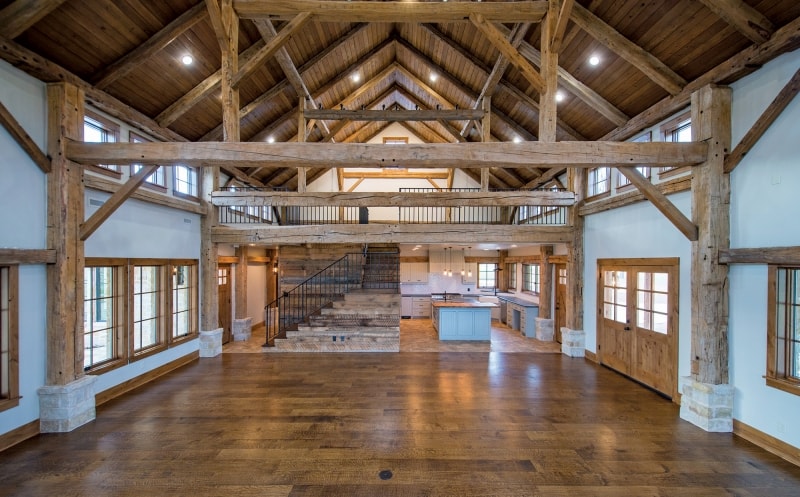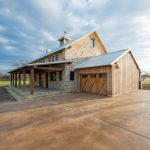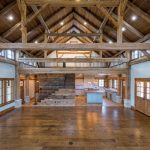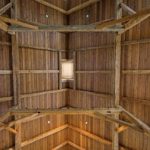
17 Dec Illuminations: Highlighting the design by Heritage Restorations
Greg Godsey, a partner in Heritage Restorations, is passionate about historic timber-frame barns. The company keeps 50 to 70 historic barn timber frames in storage lots in Texas and Montana, and it’s Godsey’s job to find the right frame for the right family.
At the Lucky Boy Ranch, west of Fort Worth, Texas, Godsey found an 1820s English-style barn frame with a swing beam. “This was a grain barn, so these frames were dedicated to threshing and storage,” Godsey says. “They would thresh the grain in the barn with a flail.”
The barn was positioned so the broad side faced the prevailing winds. Farmers would winnow, then throw the grain in the air. When they’d open the barn doors the wind blew the chaff out of the barn, and the grain, which was heavy, would fall on the floor. But that method was labor intensive and time consuming, so farmers developed a different way using oxen to stomp the grain.
“They’d tie an ox to the center pole and he would tread the grain, instead of flailing it. That’s where the swing-beam barn comes from,” says Godsey. “The biggest challenge in all the projects is trying to discern the customer’s vision for the barn. In this case, they wanted me to design a home they can farm and ranch in.”
The client was also revitalizing a pecan orchard that had gone to weeds and they wanted to live sustainably. “We put the house in the middle of the grove, where one dead pecan tree had been, and did not interrupt any of the living trees,” Godsey says. “That part was fun, looking at the slope of the land and finding the best spot to place the house.”
The 2,340-square-foot first floor and 455-square-foot loft consists of a guest room, a reading room and a master bedroom and suite as well as two-and-a-half bathrooms.
Godsey explains that people who want a historic timber-frame barn restored usually find them, as Heritage Restorations keeps a healthy inventory. “There are people in the organization scouting 300 to 400 frames a year,” Godsey says. “Yet they only bring in 10 percent of that. We’re well known in Ontario and upstate New York.”
If they don’t have the right timber frames in stock, they will go out and try to find the perfect frame for a client. “Once we have the frame, we talk about the kind of spaces they want,” Godsey says. “Usually, I go visit the customer for two or three days to understand their daily routine. What draws them together and what their family is like — routine, lifestyle — then I can put something together that really fits their needs.”
In the case of Lucky Boy Ranch, the owners also wanted to live sustainably. To that end, Godsey introduced the client to a concept called the “keyhole” garden, to help her grow her own food. A keyhole garden consists of a round raked garden bed, made of stone, with a notch cut out where you stand to tend the waist-high plants.
“You drop the compost in the compost hole and it feeds the garden,” Godsey says. “It was really satisfying to connect the clients with this feature, and we even connected them with an expert who ended up doing a seminar about the keyhole garden at their ranch.”
- A former grain barn at the Lucky Boy Ranch, west of Fort Worth, Texas, was relocated and converted into a home by Heritage Renovations.
- The swing beam, originally used to thresh and flail the wheat, remains as part of the aesthetic, keeping the historic element of the barn.
- The cathedral-style ceiling found in timber frames predates the midieval cathedral-style churches that also have a nave or center section. The word nave was used describe this volume because when you look up in the timber frame it looks like the hull of a ship.










No Comments